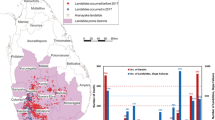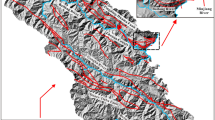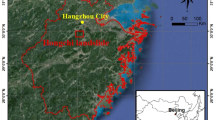Abstract
A seasonal rain front (Baiu front) accompanied a long-term accumulation of precipitation propagated over the wide areas of the main island of Japan during 15–24 July 2006. In Okaya City, Nagano Prefecture, several flow-type landslides occurred in the early morning of 19 July 2006, claiming eight lives. Among these landslides, a most peculiar complex earth slide–earth flow occurred on a north gentle slope of the upstream portion of the Motosawagawa River. In the source area, volcanoclastic soils overlying tuffaceous rocks at about 4-m depth slid due to the prolonged precipitation that raised the water table level in the soil. Along with the travel path, the failed materials fluidized causing the liquefaction of the volcanoclastic soils underlain by volcanic black ash soils. The resulting flow spread over a wide area up to the final deposition. Constant volume box-shear tests on undisturbed volcanoclastic soil specimens taken from the source area showed effective normal stress tended to decrease during shearing. The ring shear tests on saturated disturbed specimens produced the large loss of shear resistance, which may explain the fluidized motion of the complex landslide.
Similar content being viewed by others
Avoid common mistakes on your manuscript.
Introduction
A long-term accumulation of precipitation was accompanied by a seasonal rain front (Baiu front) over the wide areas of the main island of Japan during 15–24 July 2006 (the Heavy Rainfall in July 2006; Japan Meteorological Agency 2006b; a direct translation of the designated Japanese name of this heavy rainfall by Japan Meteorological Agency). Because of this rainfall, many sediment disasters occurred in the west and middle parts of Japan. Especially in Okaya City, Nagano Prefecture, several flow-type landslides occurred, claiming a total of eight victims. Although the so-called debris flow phenomena dominated these disasters, a complex earth slide–earth flow (Cruden and Varnes 1996) phenomenon occurred on a north gentle slope of the upstream portion of Motosawagawa River (Fig. 1), which first, slid and then flowed expanding its width along with the travel path. As this type of complex landslide is poorly understood, we decided to investigate the mechanism of this landslide, although it did not claim any victims. The source area had a slope gradient of only 20°; volcanoclastic soils overlying tuffaceous rocks initially slid, and as the failed volcanoclastic materials traveled downslope, they were underlain by volcanic black ash soils. As the mass movement progressed downslope, the slope gradient became more gentle slope (10°), and the landslide fluidized and spread over a wider area compared with the width of the source area.
This report presents the results of in situ investigations (simplified cone penetration tests) and the geotechnical soil tests in the laboratory, accompanied by rainfall data as the triggering factors of the landslide.
Rainfall characteristics and geological setting
Nagano Prefecture is located in the interior of the main island of Japan, and it, generally, experiences lower annual precipitation (1,700 mm) than most of Japan (Ministry of Land, Infrastructure and Transport 2004). The AMeDAS (Automated Meteorological Data Acquisition System) observatory at Suwa, which is closest to Okaya City, recorded an average annual precipitation of 1,307 mm during the 30-year period from 1971 through 2000 (Japan Meteorological Agency 2006a). However, the long-term accumulation of precipitation (the Heavy Rainfall in July 2006) accompanied by a seasonal rain front (Baiu front) fell on the Nagano Prefecture from 15 to 19 July, and a new record for monthly rainfall at the Suwa observatory was set (506.5 mm/month). The maximum hourly precipitation was only 23 mm on 17 July (Fig. 2). The hourly precipitation did not reach 20 mm on 18 and 19 July. Hence, the rainfall intensity during the Heavy Rainfall in July 2006 was not so strong and was not one of the ten highest intensity values in the period from 1948 to September 2006. However, daily precipitation, i.e., daily rainfall on 18 July (148 mm), was the second highest in this 58-year record. Furthermore, daily rainfall on 17 July (125 mm) was ranked as fifth in the same record. Accordingly, although precipitation intensity was not high, the two-consecutive-day rainfall was surprisingly large at Suwa observatory, and many flow-type landslides were triggered. The cumulative precipitation for 5 days was almost 400 mm.
The area around the complex Motosawagawa landslide (an earth slide–earth flow) is underlain by only lava and volcanoclastics. The active fault (the Itoigawa–Shizuoka tectonic line) strikes northwest–southeast direction just northeast of the landslide site. The source zone for the landslide is located at 980 m above sea level.
In situ investigation
The sliding mass was about 60 m long and 30 m wide, and the maximum soil depth was estimated at about 4 m based on survey data using a prism total station (Fig. 3a and b). Some positions of simplified cone penetration tests conducted on the periphery of the source area are shown in Fig. 3b, and these were corresponding to Fig. 4. Nc10 values indicate the number of times required for a 5-kg weight dropped from a height of 0.50 m to drive the cone 0.10 m into the soil (Fig. 4). Nc10 was assumed to define the surface layer of volcanoclastic soils (10 ≥ Nc10 ≥ 0). Soil depth ranged from 0.7 m (at CP-a) to 3 m (CP-A). Because the maximum soil depth in the landslide mass was 4 m, the deeper portion of the volcanoclastic soil mass defined the sliding plane.
Clear exposures of tuffaceous rocks were apparent along both flanks of the landslide (Fig. 5). Because these rocks must have had a lower permeability, the excess precipitation must have raised the subsurface water table level into the overlying volcanoclastic soils and triggered the sliding failure. An important point is that the failed materials traveled downslope expanding in width until deposition occurred (Fig. 1). Hence, the failed material did not just move downward along the channel, but it widened the travel width while changing into a flow and traveling about 350 m down the gentle slope. The volcanic black ash soils were found along the travel path; the depth of volcanic black ash soils was >1 m, about 100 m downslope of the source area (Fig. 6a) and about 0.3 m at a distance 190 m from the source area (Fig. 6b). The volcanic black ash soils contain much organic matter; therefore, these must have been located at the ground surface layer before the volcanoclastic sedimentation. Permeability tests on undisturbed volcanoclastic soils and volcanic black ash soils sampled by 100-ml steel tubes (height = −50 mm) produced values of 5.8 × 10−6 and 1.1 × 10−6 m/s, respectively. As the volcanic black ash soils had a lower permeability, the volcanoclastic soils overlying black ash soils could have been fully saturated due to the extended precipitation in July 2006. When the failed materials moved downslope, pore pressure within the volcanoclastic soils was likely generated due to the impact of the failed materials on the volcanic black ash soils resulting in the liquefaction and lateral expansion of the flow.
Geotechnical soil tests
To obtain the geotechnical properties and examine the shear behavior of the volcanoclastic soils, three box-shear tests were conducted on undisturbed samples under constant volume conditions, and two ring shear tests were conducted on disturbed samples. The volcanoclastic soils sampled had specific gravity Gs = 2.46, uniformity coefficient Uc = 12.5, and mean diameter D 50 = 0.020 mm. The test identification numbers and physical conditions for the box-shear and ring shear tests are shown in Table 1.
Three constant volume box-shear tests on the undisturbed specimens
Undisturbed specimens of volcanoclastic soils were sampled from the head scarp at a depth of 2.5 m deep for box-shear tests. The rectangular stainless steel shear boxes (0.06 m high, 0.10 m wide, and 0.10 m long) were driven into the soils by hammering a plastic plate placed on top of the shear box. The three sampled specimens were saturated by soaking in water for more than 24 h and then consolidated at 5.5, 30, and 50 kPa of normal stress. If the volcanoclastic soils were completely saturated on the slope, the normal stress would have been about 30 kPa. Hence, the specimen consolidated at 5.5 kPa normal stress was considerably overconsolidated. A constant shear speed of 0.5 mm/min was applied during the entire test.
The effective stress path of test BS-1 with the overconsolidated specimen mostly moved right upward, as the effective normal stress was increased (Fig. 7). In contrast, the effective stress paths of tests BS-2 and BS-3 moved left upward until reaching the failure envelop line, then they proceeded in a left downward direction closely along with the failure envelop line. During the tests, the effective normal stress was greatly reduced, indicating that excessive pore pressure must have been generated along the sliding surface of the landslide mass if saturated undrained conditions were maintained. Although the overconsolidated specimen produced a larger effective normal stress than that of initial consolidation, the normally consolidated specimens produced larger excess pore pressures that led to the loss of shear resistance resulting in the flow behavior after initial sliding.
Two ring shear tests on disturbed specimens
As the shear displacement that can be simulated in the box-shear tests was limited (about 10 mm), shear behavior for large shear displacements could not be assessed by this method. To quantitatively evaluate excess pore pressure generation and the resulting shearing resistance loss associated with large shear displacements, ring shear tests were conducted. Because it is difficult to use undisturbed specimens in ring shear tests, disturbed samples were used. The donut shaped shear box of the ring shear apparatus has an inner diameter of 0.12 m and an outer diameter of 0.18 m. The height of the specimens after consolidation was in general adjusted to 60 mm, and the shear surface was formed near the middle of the specimens.
The ring shear testing apparatus can be performed both with monotonic and cyclic loading conditions in the normal and shear directions under the undrained conditions (Sassa et al. 2003; Okada et al. 2005). To examine the shear behavior, two tests were conducted: (1) constant monotonic shear stress loading test under naturally drained conditions and (2) stress-controlled test with backpressure increased.
Naturally drained test
In laboratory studies of liquefaction phenomenon, excess pore pressure behavior under saturated undrained conditions has primarily been examined as the basic information of tested soils (Okada et al. 2004). To understand the motion of flow-type landslides, it is important to assess excess pore pressure behavior under natural conditions in the shear zones of landslides. For natural conditions, the generation and dissipation of excess pore pressure in the shear zone will occur simultaneously. The shear behavior of many actual landslides will differ from findings obtained in undrained laboratory tests. Therefore, our test was conducted under naturally drained conditions (the drainage valve of the shear box was open during the test) in which shear stress was monotonically increased at 1 kPa/s.
When shear stress was increased, pore pressure started to increase from about 55 s (Fig. 8b). At 100 s, shear resistance reached peak value of 59 kPa with pore pressure still increasing as shear displacement started to increase (Fig. 8b). Pore pressure peaked at 110 s. From 110 to 160 s, shear resistance and pore pressure gradually decreased and shear displacement increased exponentially. Once the drain valve was closed to simulate undrained conditions, shear resistance dropped to as low as 22 kPa at steady state conditions at which time the test was terminated at a shear displacement of 4,500 mm (Fig. 8b). During this period, pore pressure fluctuated but, in general, did not increase. The effective stress path rose from the beginning of the test and peaked well below the failure line obtained for drained conditions (Fig. 8a). Afterward, the effective stress path moved left downward and then right downward. When shear resistance decreased to 31 kPa, the drainage valve was closed.
The soils within the shear zone (Fig. 9, designated by a red line) were light brown compared with the darker soils under the shear zone. The grain size distribution curve of soils after shearing shifted to the left of the “before-shearing” curve, indicating that soil grains may have become finer due to the shearing (Fig. 10). These results suggest that sliding surface liquefaction (Sassa 1996; Sassa et al. 1996) may have occurred due to grain crushing and comminution when the effective normal stress and shear resistance decreased.
Stress-controlled test with backpressure increased
The complex earth slide-earth flow in Okaya city was due to a long-term accumulation of precipitation. Hence, the extended precipitation must have raised the subsurface water table level, resulting in an increase in pore pressure within the volcanoclastic soils. To reproduce these conditions, a stress-controlled test with backpressure increased was conducted.
The initial stress point was set at a 20° gradient on a stress diagram corresponding to the gradient in the source area of the landslide (Fig. 11). Pore pressure was manually increased throughout the test. Beginning at 730 s, shear displacement started to increase slightly, and beginning at 785 s, shear resistance decreased until 25 kPa. At 815 s, the drain valve was closed to convert to undrained conditions (Fig. 11b). After that, pore pressure continued increasing to 79 kPa, and shear resistance declined to 18 kPa at 2,500 mm shear displacement. These results caused a loss of shear resistance even when the drain valve was open (785 to 815 s), indicating that the soil may have slid due to water table rise up with increasing pore pressure and corresponding declines in shear resistance over the travel distance.
Summary and concluding remarks
A complex earth slide–earth flow was triggered on a north slope of the upstream portion of the Motosawagawa River in Okaya City due to prolonged precipitation associated with “ the Heavy Rainfall in July 2006.” The complex landslide traveled a long distance on a gentle slope where the slope angle at the source area was about 20° and that of travel area was <10°. During our first visit to the site, we were surprised that the landslide occurred on this gentle slope and why it spread widely over a 350-m path. A possible explanation for this complex landslide is the deeper volcanoclastic soils (≈4 m) in the source area that overlay tuffaceous rocks contrasted by the less deep soils overlying volcanic black ash soils along the travel path (Fig. 12). Because the tuffaceous rocks and the volcanic black ash soils may have had lower permeability, the volcanoclastic soils overlying them were fully saturated due to the excess precipitation. When the mass slid at the source area due to pore pressure increases, the failed sliding mass started to reduce its shearing resistance by the excess pore pressure generated because of the shearing effect. And then, the sliding mass may have impacted the saturated volcanoclastic soils above the volcanic black ash soils, leading to liquefaction within the volcanoclastic soils and causing a spreading of the flow during movement downslope.
It is generally believed that shallow, rapid landslides on rather steep slopes are strongly related to rainfall intensity (Sidle and Ochiai 2006). However, the complex earth slide–earth flow in Okaya City was induced by prolonged rainfall of relatively low intensity on a rather gentle slope. Such phenomena are not well understood and further investigation is needed.
References
Cruden DM, Varnes DJ (1996) Landslide types and processes. In: Turner AK, Schuster RL (eds) Landslides investigation and mitigation, special report 247. Transportation Research Board, National Research Council, Washington, pp 36–75
Japan Meteorological Agency (2006a) http://www.data.kishou.go.jp (in Japanese)
Japan Meteorological Agency (2006b) Press release materials (26 July 2006). http://www.jma.go.jp/jma/press/0607/26a/meimei.html (in Japanese)
Ministry of Land, Infrastructure and Transport (2004) http://www.mlit.go.jp/tochimizushigen/mizsei/hakusyo/h16/index.html (in Japanese)
Okada Y, Sassa K, Fukuoka H (2004) Excess pore pressure and grain crushing of sands by means of undrained and naturally drained ring-shear tests. Eng Geol 75:325–343
Okada Y, Sassa K, Fukuoka H (2005) Undrained shear behaviour of sands subjected to large shear displacement and estimation of excess pore-pressure generation from drained ring shear tests. Can Geotech J 42(3):787–803
Sassa K (1996) Prediction of earthquake induced landslides. Special Lecture at 7th International symposium on landslides. Landslides 1:115–132
Sassa K, Fukuoka H, Scarascia-Mugnozza G, Evans S (1996) Earthquake-induced-landslides: distribution, motion and mechanisms. Special Issue for the great Hanshin earthquake disasters. Soil Found 53–64
Sassa K, Wang GH, Fukuoka H (2003) Performing undrained shear tests on saturated sands in a new intelligent type of ring shear apparatus. ASTM Geotech Test J 26(3):1–9
Sidle RC, Ochiai H (2006) Landslides: processes, prediction, and land use. Water resources monograph 18. American Geophysical Union, Washington
Acknowledgment
The authors wish to thank Mr. U. Kurokawa, Dr. T. Okamoto, Ms. Y. Ichikawa, and Dr. Y. Tada of the Forestry and Forest Products Research Institute for their great help in the field investigations. Our sincere thanks are offered to Mr. H. Miyajima for help with conducting laboratory tests. Finally, we wish to thank Prof. R. C. Sidle for intensive review.
Author information
Authors and Affiliations
Corresponding author
Rights and permissions
About this article
Cite this article
Okada, Y., Ochiai, H., Okamoto, T. et al. A complex earth slide–earth flow induction by the heavy rainfall in July 2006, Okaya City, Nagano Prefecture, Japan. Landslides 4, 197–203 (2007). https://doi.org/10.1007/s10346-006-0075-7
Received:
Accepted:
Published:
Issue Date:
DOI: https://doi.org/10.1007/s10346-006-0075-7
















